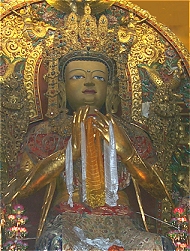 |
Buddhism |
|
A stupa is a large mound believed to be built over the remains of the Buddha or some other saint. Not necessarily the whole remains, of course, in European terms a stupa is something like a reliquiary and needs only hold a tiny part of the holy body. In Katmandu we drove past a few early stupas which were simple mounds covered in turf, but the ones the tourists get taken to see are very elaborate whitewashed mounds, surrounded by a wall of bells, prayer wheels and idols. On top of the mound is a tall square tower, each layer of which has an elaborate symbolism, the most noticeable part being the eyes of Buddha which are painted on all four sides. From the top of the tower, strings of prayer flags are stretched out towards the surrounding wall, making it look like a giant maypole. Swayambunath stupa is at the top of a landscaped hill and is accessed by pilgrims using 365 steep steps. It is set in a large courtyard surrounded on most sides by buildings. Many of these contain souvenir shops but a few appear to be monasteries and possibly dormitories for pilgrims. Buddhist and Hindu buildings are scattered around the courtyard without any obvious organisation. There are small stupas offered by the families of deceased people, temples and free-standing statues. The main stupa is framed by two tall tower shaped buildings, whose appearance is supposed to be reminiscent of the Himalayas. Our guide, who was not very good, soon gave up his explanations and switched to sales talk, but thanks to his habit of addressing all his remarks and attention to people's husbands I was able to give him the slip and look around for quite a while. Mike spent most of this time resisting our guide's attempts to convince him that he really needed a meditation bowl. From the platform that looks out over Katmandu close to the top of the 365 stairs you can get a very good view of what is going on around the complex. People reach the top of the stairs and begin walking around the stupa in a clockwise direction. Each prayer wheel is spun. When a statue of a god is reached, they touch the god's forehead, then their own. When a niche containing a god is reached, they bow in prayer to the god. When the prayer wheels are spun the prayers are released into the world. Its very important to do the spinning and walking in the right direction. You can imagine that if the direction is reversed, the prayers start getting sucked back out of the world. Similarly when a prayer flag is flapped by the wind the prayer printed on it is released. Prayer flags are never taken down, they just blow to shreds in the wind and finally disintegrate. You can always see old, grey ones alongside the bright new ones. I have also read that it is a custom in some parts to paste religious inscriptions on bridges, the prayers are then carried downstream by the flowing water. People do not necessarily take religious worship too seriously. A Nepalese lady in traditional costume found that a monkey had usurped the place of a god in one of the niches. This gave her and her group a lot of amusement before they dislodged it and got back to their prayers. There are many tourists at the stupa who must certainly come from Buddhist countries, perhaps Japan, and they are carrying out approximately the same prayer actions as the Nepalese. Some Indian tourists (presumably Hindu) walk round the stupa with both hands clasped, as a gesture of respect. European and American tourists on the other hand are mere observers like me. They can be seen darting to and fro snapping pictures, taking videos or sometimes just sitting around. |
|